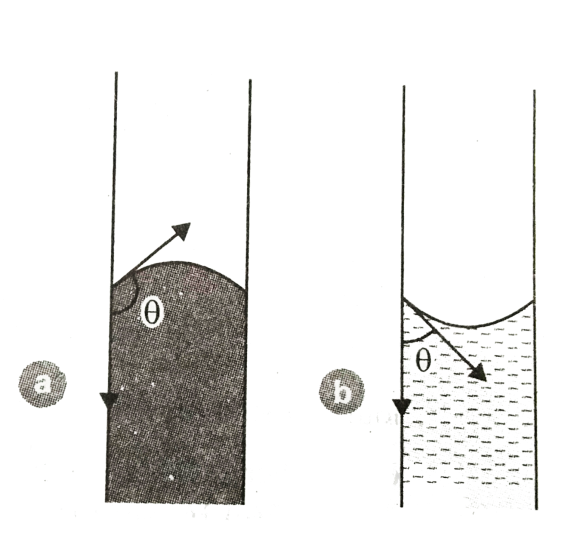
The rise in the water level in a capillary tube of radius 0.07 cm when dipped vertically in a beaker containing water of surface tension 0.07 \[N{m^{ - 1}}\] is $(g = 10m{s^{ - 2}})$
(A) 2 cm
(B) 4 cm
(C) 1.5 cm
(D) 3 cm
Answer
165.3k+ views
Hint When a capillary tube is inserted in water or any other liquid. It experiences capillary rise or fall depending on the density of the liquid. We know that the rise in height of the capillary is directly proportional to surface tension and angle of contact. Also, it is inversely proportional to the radius of the tube, the density of the liquid, and the acceleration due to gravity.
Complete step-by-step answer:
We are given that the radius of the capillary tube is, $r = 0.07cm = 0.07 \times {10^{ - 2}}m$
The surface tension of water is also given, $S = 0.07N{m^{ - 1}}$ .
We know that the density of water is, $\rho = {10^3}kg{m^{ - 3}}$ .
The angle of contact for water is zero degrees.
Using the expression for the rise in the capillary tube : $h = \dfrac{{2S\cos \theta }}{{r\rho g}}$
Where h is the rise of a liquid in a capillary tube
S is the surface tension of the liquid used in the capillary tube
$\theta $ is the angle of contact
r is the radius of the capillary tube
$\rho $ is the density of the liquid
and g is the acceleration due to gravity
Now, substituting all the given values in the expression for h, we get
$
\Rightarrow h = \dfrac{{2 \times 0.07 \times \cos 0^\circ }}{{0.07 \times {{10}^{ - 2}} \times {{10}^3} \times 10}} \\
\Rightarrow h = 2 \times {10^{ - 2}}m \\
\Rightarrow h = 2cm \\
$
Therefore, option (A) is correct.
Note The angle of contact is the angle that a perpendicular to the walls of the capillary makes with the meniscus of the liquid at the point of contact.

This is a diagram of two liquids where liquid(a) has a convex meniscus $(\theta > 90^\circ )$ and liquid(b) has a concave meniscus $(\theta > 90^\circ )$. For water, the meniscus is flat. Therefore, the angle of contact is zero for water.
Complete step-by-step answer:
We are given that the radius of the capillary tube is, $r = 0.07cm = 0.07 \times {10^{ - 2}}m$
The surface tension of water is also given, $S = 0.07N{m^{ - 1}}$ .
We know that the density of water is, $\rho = {10^3}kg{m^{ - 3}}$ .
The angle of contact for water is zero degrees.
Using the expression for the rise in the capillary tube : $h = \dfrac{{2S\cos \theta }}{{r\rho g}}$
Where h is the rise of a liquid in a capillary tube
S is the surface tension of the liquid used in the capillary tube
$\theta $ is the angle of contact
r is the radius of the capillary tube
$\rho $ is the density of the liquid
and g is the acceleration due to gravity
Now, substituting all the given values in the expression for h, we get
$
\Rightarrow h = \dfrac{{2 \times 0.07 \times \cos 0^\circ }}{{0.07 \times {{10}^{ - 2}} \times {{10}^3} \times 10}} \\
\Rightarrow h = 2 \times {10^{ - 2}}m \\
\Rightarrow h = 2cm \\
$
Therefore, option (A) is correct.
Note The angle of contact is the angle that a perpendicular to the walls of the capillary makes with the meniscus of the liquid at the point of contact.

This is a diagram of two liquids where liquid(a) has a convex meniscus $(\theta > 90^\circ )$ and liquid(b) has a concave meniscus $(\theta > 90^\circ )$. For water, the meniscus is flat. Therefore, the angle of contact is zero for water.
Recently Updated Pages
JEE Main 2021 July 25 Shift 1 Question Paper with Answer Key

JEE Main 2021 July 22 Shift 2 Question Paper with Answer Key

How to Calculate Moment of Inertia: Step-by-Step Guide & Formulas

Dimensions of Charge: Dimensional Formula, Derivation, SI Units & Examples

Dimensions of Pressure in Physics: Formula, Derivation & SI Unit

Environmental Chemistry Chapter for JEE Main Chemistry

Trending doubts
JEE Main 2025 Session 2: Application Form (Out), Exam Dates (Released), Eligibility, & More

Combination of Capacitors - In Parallel and Series for JEE

Uniform Acceleration

Atomic Structure - Electrons, Protons, Neutrons and Atomic Models

Displacement-Time Graph and Velocity-Time Graph for JEE

JEE Main 2025: Derivation of Equation of Trajectory in Physics

Other Pages
JEE Advanced Marks vs Ranks 2025: Understanding Category-wise Qualifying Marks and Previous Year Cut-offs

NCERT Solutions for Class 11 Physics Chapter 1 Units and Measurements

NCERT Solutions for Class 11 Physics Chapter 2 Motion In A Straight Line

Units and Measurements Class 11 Notes: CBSE Physics Chapter 1

Motion in a Straight Line Class 11 Notes: CBSE Physics Chapter 2

Important Questions for CBSE Class 11 Physics Chapter 1 - Units and Measurement




